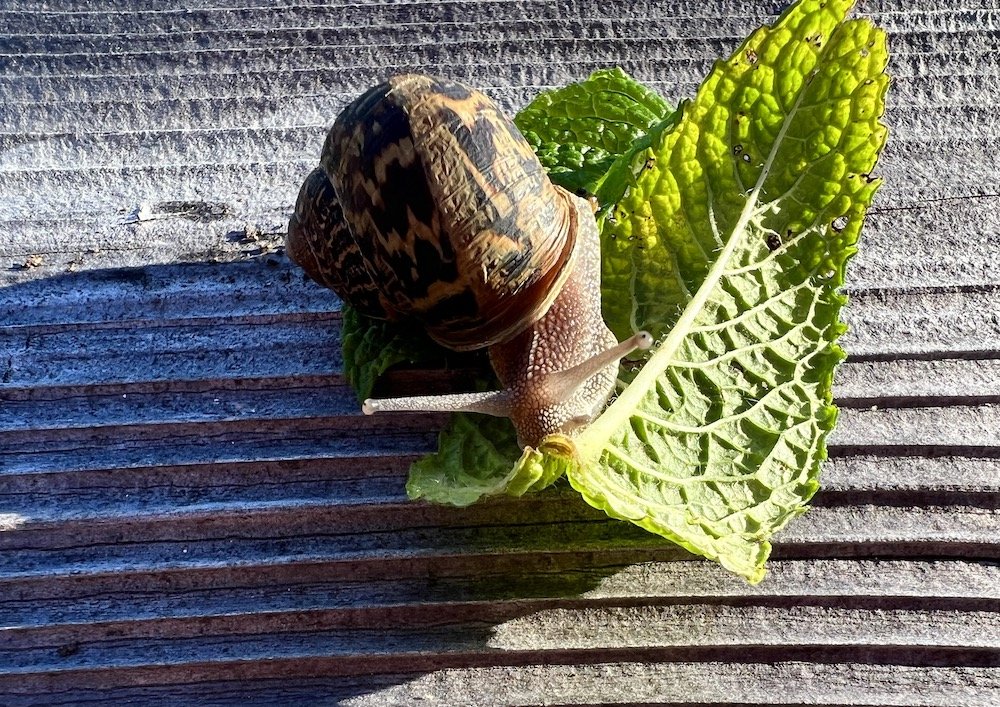You've Got Snail
“To be alive and explore nature now is to read by the light of a library as it burns.”
Our gardens are pretty good indicators of how our lives are faring. Twenty years ago, it seemed that all the snails in the neighborhood had decided to devour every plant in my yard. It didn’t occur to me then that an excess of snails (or anything else) likely meant that the mini ecosystem at my place was out of balance. Other aspects of my life were also off kilter, but I didn’t notice the connection.
Even then, I tried not to kill them. In my mental negotiations, I reasoned - if it can be thought of as reason - that stomping on an occasional snail or few was acceptable. Braver and more honest than leaving the dirty work to Sluggo. Sometimes, depending on my mood, I’d relocate them to my neighbor’s swath of ivy across the street. (She was unpleasant and annoying: another false justification.)
One day, in exasperation, I simply lobbed them in her general direction and literally let the chips (in this case, snails) fall where they may, but my efforts, and the snails, fell short: instead of landing in the ivy, the snails literally hit the road. Those that survived made their painful way across the hot asphalt. Before long, there was quite an accumulation. Just then, a mother and child walked by. (I lived on a cul-de-sac that was a safe haven for walkers and bicyclists - but not snails, to wander in the middle of the road.) The child exclaimed, Oh, Mommy, look! So many snails. I ceased my de-snailing and snuck indoors.
Our violence-saturated, violence-dependent lives are replete with efforts at justification that mostly depend on some variation of the notion of a lesser evil. In Gaza as in many other settings of conflict and duress such as refugee camps, humanitarian aid organizations, lawyers and politicians have come up with ways to calculate exactly how little electricity, food, water, sewage treatment, and access to medicine is necessary to keep life going. Since then, with each new crisis, when basic services are interrupted, the baseline drops. In the words of Eyal Weizman, known for his extraordinary work in forensic architecture, Lesser evil arguments are now used to defend anything from targeted assassinations and mercy killings, house demolitions, deportation, torture, to the use of (sometimes) non-lethal chemical weapons, the use of human shields, and even the ‘intentional targeting of some civilians if it could save more innocent lives than they cost.’
Incrementally, the unacceptable becomes acceptable. Worse, the calculus of how little is required has seeped into everything from habitat protection to facts. We no longer ask ourselves how much it might take to restore the world and human dignity; how much we might pour into the thriving of fellow humans and other-than-human selves.
These days, I gather the snails in my hand, or sometimes in a bucket, and carry them to a shady patch of weeds beyond the garden. At first, when I pick them up and hold them in my palm, they recoil into their shells. Within a minute or two, they emerge, peering at me with gentle curiosity through their antennaed eyes. Yesterday, I was literally shocked as I pried a biggie off a foxglove. It held tight until I eventually prevailed. As I pulled it loose, it sent a quivering jolt that felt like an electric current radiating through my whole hand. Belatedly, I became curious.
Sea snails appeared on Earth 550 million years ago. A couple hundred million years later, they developed lungs and moved onto land. It’s humbling to know that when I cradle a gentle, voracious snail in my palm, I am holding an ancient miracle.
Worldwide, there are more than 35,000 species of snail, 500 in the U.S. In the wild, snails live two to three years. In captivity (a terrarium) they can last up to 15 years. Besides mattering to themselves, snails are important food for birds, reptiles and small mammals. It is tempting to think, Well, they’ve been around this long. No matter how many we kill, there’ll always be more. Not so long ago, that’s how it seemed with everything from passenger pigeons to whales.
Given the frenzy of destruction these days, it may at first seem ludicrous to wonder about the morality of killing snails. That’s what I told myself, anyway. The problem is, that kind of thinking is its own slippery (in this case, slimy) slope because the question asks us to consider where we draw the line - the many lines. Mostly, it’s a meditation on our personal standard of lesser evil, the violence we are ready or forced to accept as normal and necessary. Dead snails in the garden? Insects on the windshield? Then there’s the big stuff: Gas in the car? Protein on the plate? Sending weapons to Ukraine? Doing business with Saudi Arabia? We have begged the question for so long that now the questions beg us - not just to consider them but to live by them. If all life is precious, how do we behave in response?
Years ago, a Mennonite friend told me a joke. It seems there was a man who heard a knock at the door. He had to interrupt something important to answer. When he opened the door, no one was there, only a lone snail on the welcome mat. In frustration, he picked it up and hurled it away. Two years later, there came another knock. Again, when the man opened the door, he saw only a snail on the mat. The snail looked up and said, What was that all about? Not a bad question to consider now that it’s us on the mat.
